Unwilling to return home, unable to continue their journey, thousands of Central Americans find themselves trapped in Mexico.
by Joseph Sorrentino
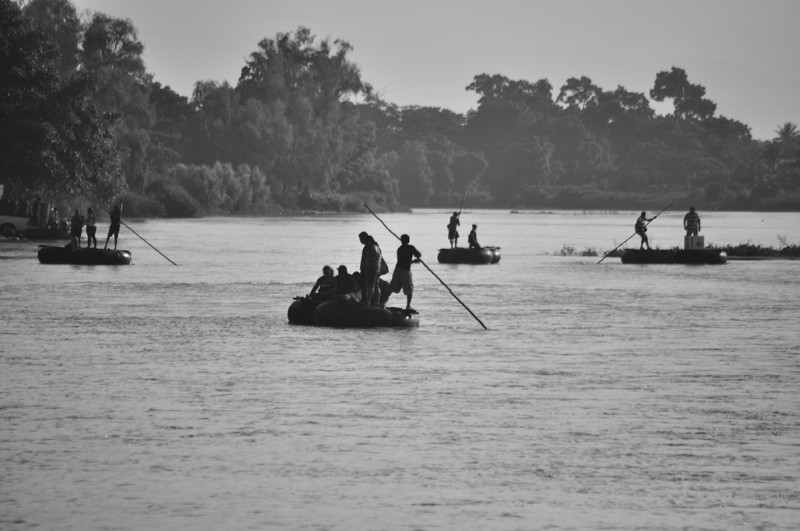
Jorge and Kevin, two friends, worked as a team on a bus in Ceiba, the third largest city in Honduras, Jorge driving and Kevin collecting money from passengers. Like virtually all bus and taxi drivers in Honduras, they had to pay renta, in their case it was to the Mara Salvatrucha, one of the most brutal gangs in the Americas. The money didn’t buy them any kind of protection; it was simple extortion. The fee was 500 lempiras (about $20) a week, which they initially paid, but eventually couldn’t afford. They knew that not paying the gang was a death sentence, so they fled to Mexico, making their way to La 72, a shelter for refugees and migrants in Tenosique, Tabasco (La 72 is named in honor of the 72 Central Americans murdered in Tamaulipas, Mexico in 2010). According to Mexican immigration law, anyone fleeing “generalized violence” qualifies for asylum, so Jorge and Kevin applied. The process takes 3 or 4 months and, after a while, Jorge decided to leave the shelter because he was desperate to get to the U.S. He was caught by Mexican Immigration (*Instituto Nacionál de Migración, *or INM) in Monterrey. Although he qualified for asylum and was already in the process of applying for it, he was deported. He was only in Honduras a few days and, according to Kevin, had gotten enough money together to return to Mexico. Before he could leave, he was murdered as he stepped out of a taxi. He was 18.
The US is at least indirectly responsible for his, and other, deaths.
An unprecedented number of Central Americans — the majority women and children — arrived at the US/Mexico border during the spring and summer of 2014. Many, if not most, were fleeing the extreme violence perpetrated by gangs like the Mara Salvatrucha and Mara 18 in the Northern Triangle countries of Guatemala, Honduras and El Salvador. The US labeled the arrival of so many Central Americans at its southern border a “humanitarian crisis.” President Obama met with Mexican president Enrique Peña Nieto in June, 2014 specifically to discuss ways that Mexico could stem the flow of migrants and refugees through that country and, especially, to prevent them from reaching the US/Mexico border. Mexico’s response was to launch Programa Frontera Sur (PFS) in August, 2014. Although Peña Nieto declared that the program would protect refugees and migrants, its main goal has been to stop them from riding the cargo trains collectively called La Bestia, The Beast.
After the program was enacted, apprehensions by the US Border Patrol the US/Mexico border dropped, and this was praised by US officials. “I very much appreciate Mexico’s efforts in addressing the unaccompanied children who we saw spiking during the summer,” said President Obama in January, 2015. “In part because of strong efforts by Mexico, including at it’s southern border, we’ve seen those numbers reduced to much more manageable levels.” He neglected to mention that INM and Mexican federal police often used brutal methods — including Tasers and beating — on refugees and migrants, have been implicated in causing several deaths, or that increased apprehensions lead to deportations which often lead to deported persons being murdered in their home countries.
In addition to pressure, the US yearly gives Mexico tens of millions of dollars, through programs like Plan Mérida, a wide-ranging program whose stated focus is fighting organized crime, in part by securing its southern border. Mexico has received $2.3 billion in aid since Plan Mérida began in 2008, with a significant portion of that money earmarked for equipment to be used to help it secure its southern border, for training INM agents and to set up mobile highway checkpoints. In FY 2015, Congress allocated up to $79 million more to aid Mexico’s enforcement at that border.
The pressure and money have done little, if anything, to seal Mexico’s southern border. People and goods still cross the Rio Suchiate, which separates Mexico and Guatemala, unimpeded. Two visits to the river and interviews with 50 migrants and asylum-seekers, almost all of whom crossed the river into Mexico on rafts, confirmed that Mexico’s southern border is as porous as ever. “By the river, I have never seen an INM agent either,” says the UNHCR’s Leclerc.
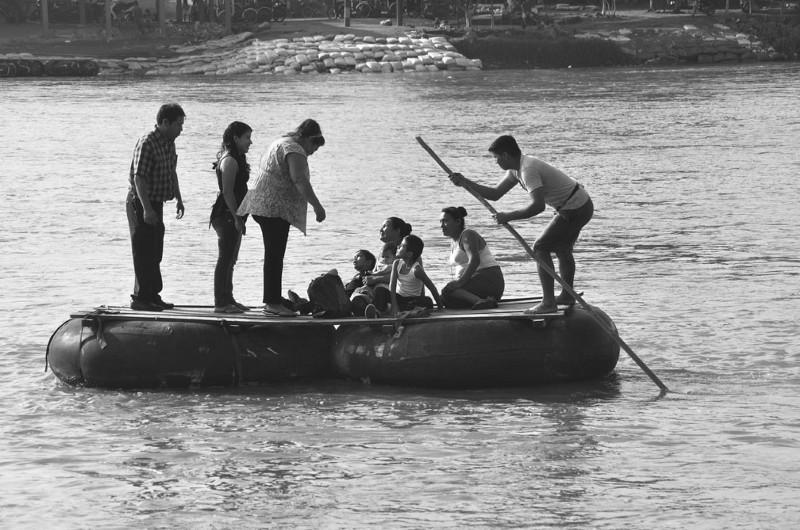
And Central American migration through Mexico continues; in fact, it’s increasing.
“Programa Frontera Sur has achieved its objective of detaining those migrants that climb the train,” says Sister Letty Gutierrez Valderrama, Director of the Scalabrianian Mission with Migrants and Refugees in Mexico City, “but it has not achieved its objective of stopping migration because violence continues in the Northern Triangle countries of Central America (Guatemala, Honduras and El Salvador).” It’s generally accepted that 400,000 Central Americans typically enter Mexico “irregularly” each year but Francesca Fontanini, the United Nations High Commission on Refugees (UNHCR) Regional Director for Communications in Latin America, thinks that number could double to 800,000 this year.
Rather than securing its southern border, Mexico has instead set up checkpoints miles north of the border and has continued to step up detentions and deportations.
Between July, 2014, when PFS was announced, and June, 2015, Mexican apprehensions of Central Americans increased by 71%. At the same time, apprehensions by the US at its southern border decreased by around 40%, largely as a result of Mexico’s efforts. President Obama, in a joint press conference with Peña Nieto in July of this year, once again praised Mexico for its efforts to stop migration through that country. “(I)f it were not for the hard work of Mexico in trying to secure its border to the south…we would have a much more significant problem.”
But the real problem is that the vast majority of apprehended Central Americans are deported.
Using data from Mexico’s Secretaria de Gobernación, Univision, the English-Spanish media conglomerate based in New York, found that Mexico deported 90% of all Central Americans detained in the first four months of 2016; 43,506 of them from the Northern Triangle countries. Advocates have no doubt of the US role in this. “The United States asked Mexico to increase detentions and deportations of migrants as a way to prevent them from arriving at our border, which it clearly did,” says Maureen Meyer, Senior Associate for Mexico and Migrant Rights at the Washington Office on Latin America (WOLA). “Mexico failed to ensure that these people were adequately screened for protection concerns, deporting many Central Americans back to the dangerous situations they were fleeing from.”
Mexico is ignoring the fact that it, along with several Central and South American countries, signed the 1984 Cartegña Declaration on Refugees. In that document, a refugee is defined as anyone fleeing “generalized violence,” which certainly applies to the Northern Triangle countries. “There is almost generalized violence in the Central American countries,” says Perrine Leclerc, the head of the UNHCR field office in Tapachula, Chiapas. “We know that it’s a refugee crisis because most of them are fleeing violence and are refugees.”
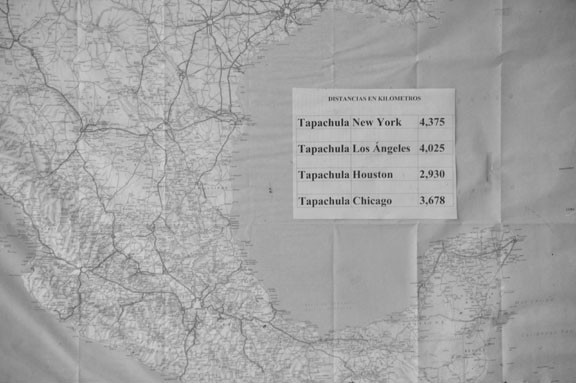
Many people fleeing the extreme violence of the Northern Triangle countries don’t know they can ask for asylum and INM agents — supposedly trained with US money — rarely provide that information (INM refused an interview request and several requests to submit questions via email).
Oscar is a 33 year old businessman who fled Guatemala and was staying in Hermanos en el Camino, a shelter in Ixtepec, Oaxaca. He’s a big man and, despite his situation, has a ready laugh. “I have a business selling clothes and (a gang) was asking for money… renta,” he says.
“I had three businesses. I closed one and then I closed the other and I couldn’t pay them and they started saying, ‘We’ll kill you.’”
He was caught twice by INM and sent back to Guatemala. “The first time I was caught,” he says, “I asked the officer, ‘How can I get papers here in Mexico?’ and he said there was no way I could get papers.” He was deported and tried again. When he was caught a second time, he says, “I didn’t ask again because I was already told I couldn’t fix no papers.”
In interviews with 50 asylum-seekers in five shelters, not one said they received information about asylum if they were stopped by INM; six shelter directors confirmed this. A report by the Inter-American Commission on Human Rights found that almost 70% of people held in Siglo XXI (Twenty-first Century), Mexico’s largest detention center in Tapachula, Chiapas, weren’t aware of their right to seek asylum. The UNCHR’s Leclerc expressed frustration about this. “We work with migration authorities to make sure that when there is contact… people have access to information,” she says. Her staff visits Siglo XXI three times a week. “We go because we know…they are not aware of their right to seek asylum,” she adds. This lack of information has resulted in less than 1% of Central Americans applying for asylum, although most of them would qualify.
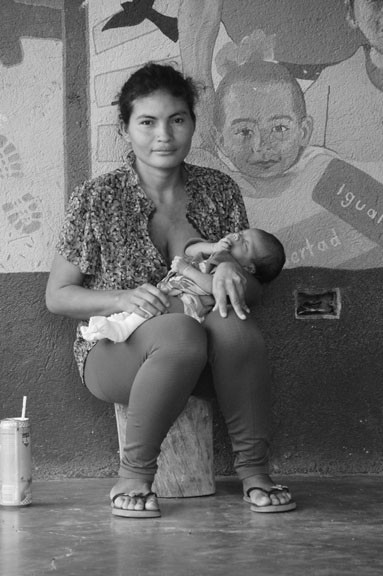
INM agents are regularly implicated in abuse of refugees and migrants. Although victims are often reluctant to report such abuse, Mexico’s Centro Nacionál de Derechos Humanos (National Center for Human Rights) reported 1,617 complaints of human rights violations against refugees and migrants between December 1, 2012 and June 15, 2015. 1,220 were against INM. Only four resulted in a formal recommendation by CNDH. But there may be one sure way to avoid abuse and detention if caught by Mexican authorities: a bribe. According to the Jesuit Service to Migrants (SJM in Spanish), 37% of Central Americans they surveyed who had been stopped by police or INM paid extortion. “It is $1,000 pesos for Federal Police,” says Arturo Gonzalez Gonzalez, the organization’s director. “$100 USD for INM.”
Those Central Americans who are detained by INM and not deported are taken to one of the country’s 32 detention centers. An investigation of nine centers by Mexican human rights organizations found that, although detainees in a few centers reported being treated “well,” there were cases of abuse in others. This included guards punching and kicking detainees, shouting, and “abuse of power.” In general, that report and others cited “poor conditions” in the centers. “In one, because there are so many people, 100 or 200 women and children…sleep standing up,” says Sister Letty. “They…do not have water…it is not that they do not just have no water to drink, there is no water for bathrooms or toilets or showers…either they did not feed them or the food was bad.” She added that there have been at least three suicides. She prefers to call the detention centers “prisons.”
Leclerc said that at Siglo XXI, families are separated — women and young children in one area, adult men in another and adolescent boys in yet another. Those applying for asylum are detained for at least three months. During that time, she says, people are not allowed outside of the center and families are only able to see each other “from time to time but cannot be together. This is one of the main reasons people don’t want to seek asylum in the detention center.”
According to COMAR (Comisión Mexicana de Ayuda a Refugiados: Mexican Commission to Help Refugees), the Mexican department that is responsible for determining a person’s refugee status, almost 40% of all asylum applications in 2015 were withdrawn or abandoned. “It’s too long a wait,” says the UNCHR’s Fontanini. “They don’t have a job, they don’t have a roof, the majority are coming without money.” People take drastic measures when the wait becomes too much. “What they do,” says Leclerc, “they sign deportation papers and once they are in their country of origin, they try to re-enter…avoid checkpoints and try to reach COMAR.”
Despite the dangers of returning to their home countries, many people choose to do it.
Victor, his wife and four children, refugees from El Salvador, spent five months in a detention center. “We were in the same station,” he says, “but we were separated. My kids, they didn’t want to eat no more. It was the same food every day. I had to decide: my kids’ health or stay in Mexico. So I decided to go back to Salvador.” This was extremely dangerous for Victor, an ex-gang member who’s trying to turn his life around. “Active gang members don’t like ex-gang members,” he says. “They put out a 187: anyone can kill you.” 187 is California penal code for murder. Several ex-gang members I interviewed had hidden their gang tattoos by covering them with new tattoos. Victor and one other ex-gang member instead tried to remove them on their own. Both had scar tissue covering their tattoos after trying to remove them with what sounded like a soldering gun.
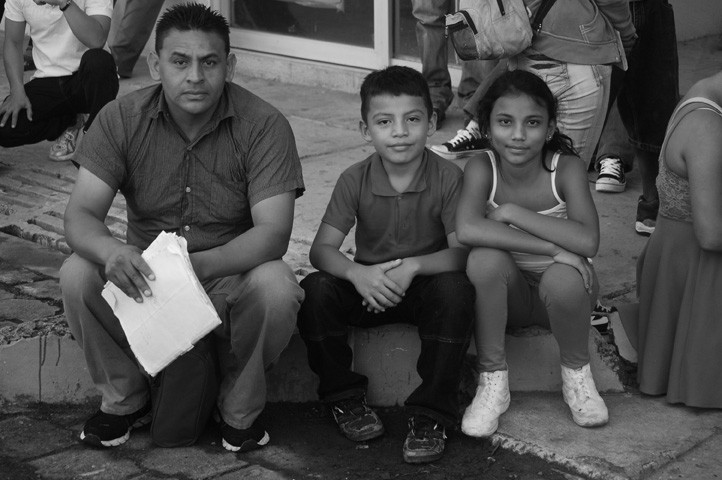
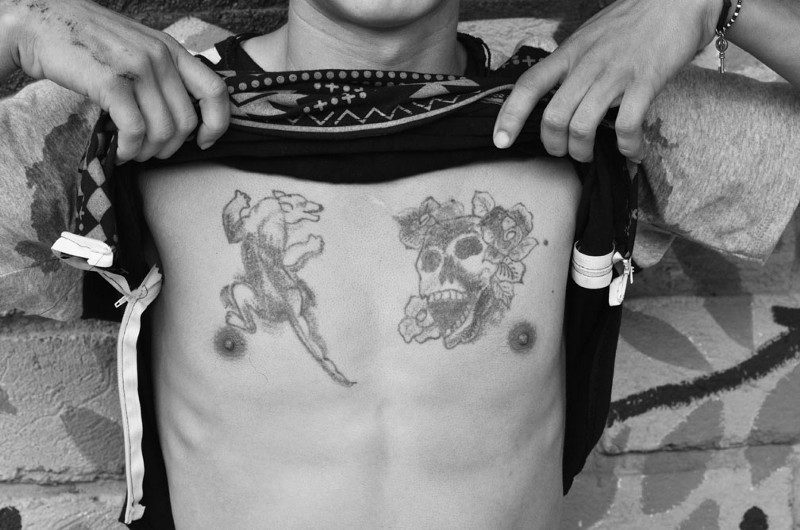
A person seeking asylum in Mexico must file an application at a COMAR office. It takes at least 45 working days to get a decision, during which time a person may be in detention, a shelter or living somewhere else. If they live outside of a detention center, they must report every Monday to a COMAR or INM office to sign a paper proving they’re still in the country. There are only three COMAR offices and four INM offices in all of Mexico, which means a long trip for many people. Those staying at Hermanos en el Camino in Ixtepec, for example, must go to the INM office in Salina Cruz, which means traveling almost 2 hours each way. In Tapachula, the COMAR office opens at 9:00 but people begin lining up as early as 3:00 or 4:00. By 8:00, a couple of hundred people have gathered on the stairs and line one side of the building. The sign-in usually takes 7 or 8 hours, primarily because there are so few officers. There are only 15 in the entire country. If a person misses the sign-in twice, their application is considered abandoned and, if caught, they will be deported.
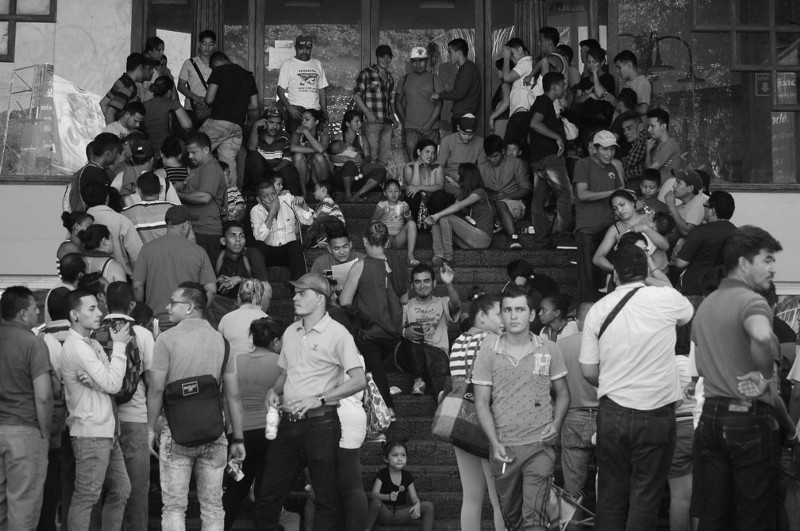
For asylum-seekers living in a shelter or independently, a trip to a COMAR office — or anywhere — can be risky. According to Leclerc, if an asylum-seeker is asked by INM agents for identification when they’re on their way to the office or, perhaps, sitting in a park, agents can, by law, take that person to a detention center which can put them at risk of deportation. “A person may not have their asylum certificate with them,” she says. “Or sometimes they have their documents but officials at the center don’t know what kind of document it is. We had a case of a person who didn’t say she was a refugee; it’s hard for them to know their rights. She was in detention and did not say, ‘I am a refugee.’ She was deported.” On the last Sunday in June, Leclerc said that INM agents went through the main park in Tapachula checking the documents of anyone they suspected of being from Central America. “Tapachula is trying to show it’s a good city for business,” she says, “and because of the high influx of migrants, public parks were places where lots of migrants are sleeping. There had been some complaints and requests to clear it and give the city a better image.”
Marooned
As dusk settles, many of the nearly 200 people staying at Hermanos en el Camino, a shelter for Central American refugees and migrants in Ixtepec, Oaxaca, pull their thin foam mattresses from the dormitories and lay them on the concrete walkway. Ixtepec is located on the Mexican Isthmus where summer temperatures hover around 90 with high humidity. Night brings some relief but the dormitories have little ventilation, so many people prefer to sleep outside. Couples, who are housed in different buildings, gather and snuggle on the mattresses. Children kick a soccer ball nearby until it’s too dark to see. In the morning, people stow their mattresses, wash up in a common bathroom and begin their day. A few men start chopping wood for the kitchen. A couple of women sweep the walkways. The rest wait for breakfast. The majority of people staying in this shelter — and in shelters across Mexico — are waiting for a humanitarian visa or to be granted asylum. A humanitarian visa is given when a person has been a victim of a crime and is willing to file a report. Once granted, it allows a person to travel through Mexico for a year. Virtually everyone at the shelter was applying for this visa.
During the time that the applications are processed — and both take three to four months — travel is restricted, a person can’t work and they’re living in shelters that offer, at best, rudimentary accommodations. “There’s no privacy,” says Orlin, a 32 year old Honduran refugee staying at Hermanos en el Camino, who’s waiting for a visa, “we have to sleep on the floor…they don’t got no sheets so you can’t cover yourself when it’s cold. You have to get used to it. I no feel happy but I have to do it. I just need one more month…and then take off.” Because they can’t travel, “It’s like you’re locked up,” says Oscar, the Guatemalan refugee. “Some days I’m stressed out, I want to go back home.” He added however, that the shelter staff “treat us good.”
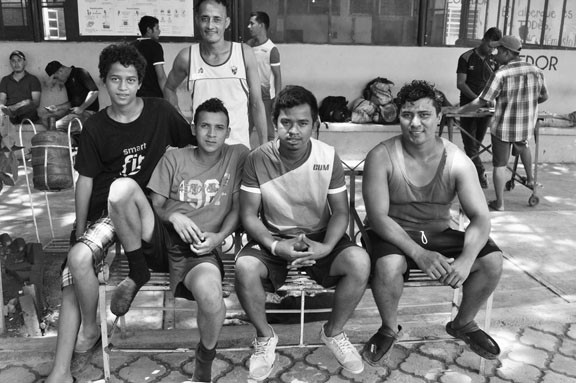
Although they’re not supposed to work until their applications are approved, a number of people I interviewed did. In Menores en el Camino, a shelter for youth in Oaxaca, several of the young men worked in the huge fruit and vegetable market in the city, loading and unloading trucks carrying crates of mangos. They earned 150 pesos for 15 hours of work; a little over $8.
“Mexicans may be paid a little more,” says Freddie, one of the young men. “The whole world mistreats Central Americans.”
Orlin and Oscar both worked a couple of days a week in Ixtepec, also unloading fruit trucks, earning 200 pesos. One day, when there was no work, Orlin went to Juchitán, a larger city about 40 minutes away by bus. There he told me he was doing “charoliar”: begging. After subtracting the 40 pesos for the round-trip bus fare, he earned almost 100 pesos for work that was a lot easier than unloading trucks.

When I visited Hermanos en el Camino in 2012, people were still riding La Bestia, stopping at that shelter, and shelters across Mexico, for just a short time; maybe just for a meal or a day or two at most before continuing their journey north. Now, shelters designed to house people for a few days are often housing people for months (some shelters still restrict the length of stay to days and then people have to find other accommodations). In 2012, the majority of travelers were single men and most were heading to the US to find work. The population is different now. “There is an increased presence of women and children,” says Sister Letty; other shelter directors and the UNHCR also reported a large increase in the number of families. The majority of people are leaving the Northern Triangle countries because of the extreme violence. “Most families we see,” added Leclerc, “one family member has been assassinated.” There has also been a large increase in the number of LGBTI fleeing Northern Triangle countries.
Shelters are full and more people arrive daily. Larger shelters like Hermanos en el Camino, although usually full, will find a way to absorb more people. “We will never close,” says shelter director Donis Rodriguez. “We can have people sleeping outside, we can always give them food.” That’s not always possible at smaller shelters. There were a couple of times when I was at Menores en el Camino when a meal wasn’t served; either no one prepared it or maybe there wasn’t food. But residents didn’t mind. “I’d rather be hungry here,” said Marcos, a former Mara Salvatrucha member, “than there, where they will kill me.”

The UNHCR recognizes that this is a rapidly growing — and worsening — humanitarian crisis. “What we’re getting ready for is a huge influx,” says Leclerc. “There were 3,400 asylum seekers in 2015 and we estimate in 2016 it can reach 10,000. That’s why in 2016, there has been a huge response to increase shelter capacity…In Tapachula…we have had more than 100 new beds for asylum seekers…In Buen Pastor (another shelter), nine modules for families that can receive up to 55 people, 48 beds for single men.” The UNHCR is also offering modest cash assistance to help asylum seekers with rent when shelters can’t accommodate more people.
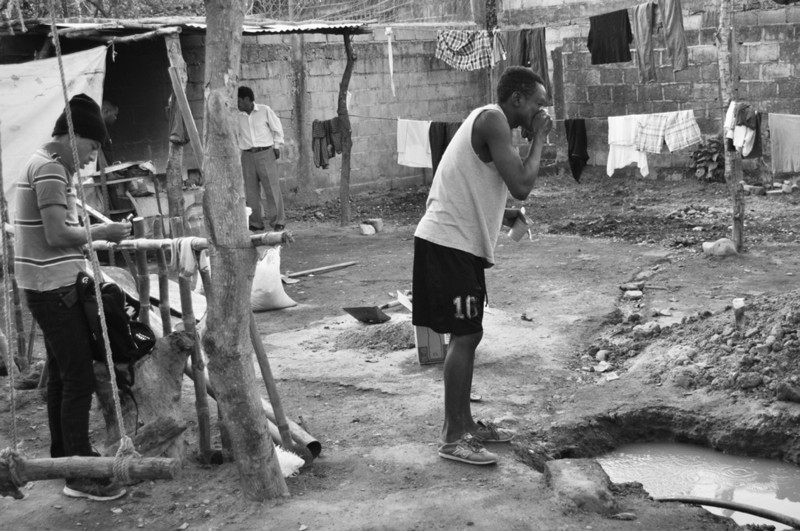
Juan Alberto has a weary yet determined look in his eyes. He lives in a two-bedroom apartment with his wife, two sons and two grandchildren. They fled Honduras after Mara Salvatrucha killed another son and grandson. Their apartment is on the outskirts of Tapachula, where the roads are packed dirt. A short bridge spans a stagnant pool of water a short distance from where they live. The apartment has a large, empty front room. To the right are two small bedrooms with either old mattresses or sleeping bags on the floor. The kitchen is in the back, a small plastic table, one small wooden table and a few plastic chairs the only furniture. A two-burner electric hot plate is all they have for cooking. I don’t recall seeing any lamps. “UNCHR is helping with rent and a little food,” says Juan Alberto. “Not all, but some. If we did not have their help, I do not know where we would be.” To supplement their income, one son works construction, although legally he’s not supposed to, earning 170 pesos a day (less than $10) for 10 hours. Life in a strange country is difficult.
“I feel sad because I have nothing here. There are many differences: different customs, different food. You ask for something by the name we use in my country and they do not understand you.”
When asked if he misses his home, he says, “Oh, so much! If there was no Mara, we would still be there.” He shows me some family photos on his phone, including ones of the son who was murdered. When I ask what would happen if the family returned to Honduras, he slowly moved his finger across his neck. He and Chara, his 8 year old granddaughter, walk with me to where I can catch a taxi back to the city. I have to insist that they let me buy something to drink. Chara chooses a large bottle of Sprite. Juan Alberto hands it to her and sends her home. “We will drink that tonight,” he says.
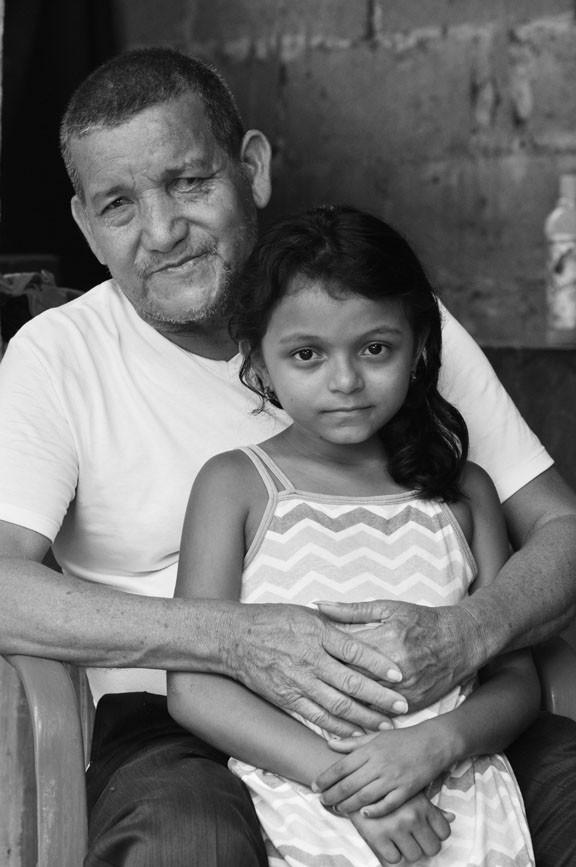
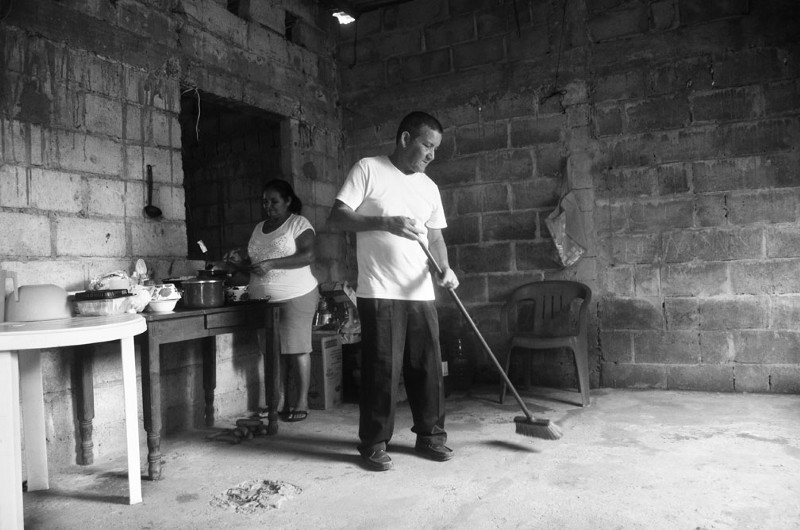
Despite policies like Programa Frontera Sur, increased deportations from Mexico and US pressure and money, the number of Central Americans entering Mexico continues to increase and, as the UNHCR’s Fontanini said, could reach 800,000 this year. The UNHCR believes that Mexico is no longer just a country of transit but a country of destination but it’s not clear that people are actually choosing Mexico as a place to live.
The UNHCR is convinced that Mexico can absorb many more refugees than it currently does. They point to the fact that, although increasing, the number of asylum applications may still only approach 10,000 this year and Mexico can easily accommodate them. But since the majority of people fleeing the Northern Triangle countries are fleeing “generalized violence,” they would qualify for asylum. It’s not at all clear that Mexico, which is focusing its immigration policy on deportation, will change that focus. And if it does, if it can handle a huge influx of refugees.
Although it’s difficult to determine exactly how many shelter beds there are in Mexico, it’s clear that right now there aren’t enough. The UNHCR is funding more and building family units as quickly as possible but they’re adding, at best, a few hundred spaces while the number of people qualifying for asylum could realistically number in the tens of thousands. When there’s no space in shelters, “People rent small rooms or live in parks and under bridges,” says Gonzalez Gonzalez, although renting a room may prove impossible if a person can’t work.
If Mexico is indeed being viewed as a country of destination, it’s usually not by choice. Mexico, and other countries in Latin America, are chosen because there may be no other option.
“We see a radical change,” says Leclerc, “because most of them staying now think, ‘I don’t care. I just want to be safe.’ So Mexico or anywhere else doesn’t matter.”
Not all advocates agree that Mexico is a country of destination and many people I interviewed said they still wanted to cross into the US. And, as Sister Letty points out, Mexico has its own migration problems. “UNHCR and others …they are missing the fact that Mexicans are also trying to get away from violence,” she says. “They are saying that Mexico is a country of destination but they do not talk about Mexicans who are also fleeing. My sisters in Tijuana are receiving women from Guererro, Michoacan, Mexico state.” Fontanini, the UNHCR Communications Director, points out that, in addition to Mexico, other Latin American countries, like Nicaragua, Panama and Costa Rica are also taking in more asylum-seekers. But, as WOLA’s Maureen Meyer says, “You don’t go to Nicaragua looking for a better paying job.” People are going there or Mexico because it’s at least marginally safer than their home countries.
It’s not clear if people who are granted asylum in Mexico can find work that can support them. “There is work,” says Sister Letty, “but not good remuneration.” The majority of advocates agree with her but Leclerc is more optimistic, noting that the UNHCR is explaining to businessmen that it’s legal to hire refugees who have resident status. “It will take some time to raise awareness,” she says. “There are some productive solutions.” But even if businessmen start hiring refugees, it means a handful of jobs when thousands will need them. And then there are Mexicans who need work.
Every main street in every large Mexican city is lined with people — many of them internally displaced — selling whatever they can to earn some money. I spent several days talking to ambulantes — street vendors — and jornaleros — day laborers — in Mexico City.
Marta stood on a street corner along Avenida Insurgentes, a small basket with baked goods at her feet. “I earn about 100 or 150 pesos a day (about $6 to $8),” she says, adding her husband earns about the same at another location. “We need about 300 pesos ($17) a day to live.” Asked how they can survive, she replied, “We live economically, basic foods and nothing else.” The story was the same for other ambulantes. Jornaleros in Mexico city’s San Angel neighborhood made about 300 pesos a day working construction. All of the workers said there was no better paying work for them in Mexico.
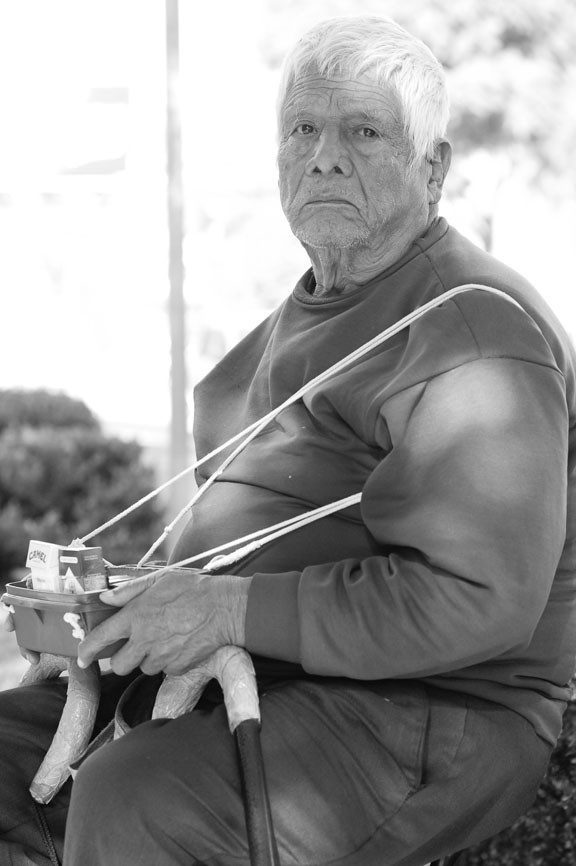
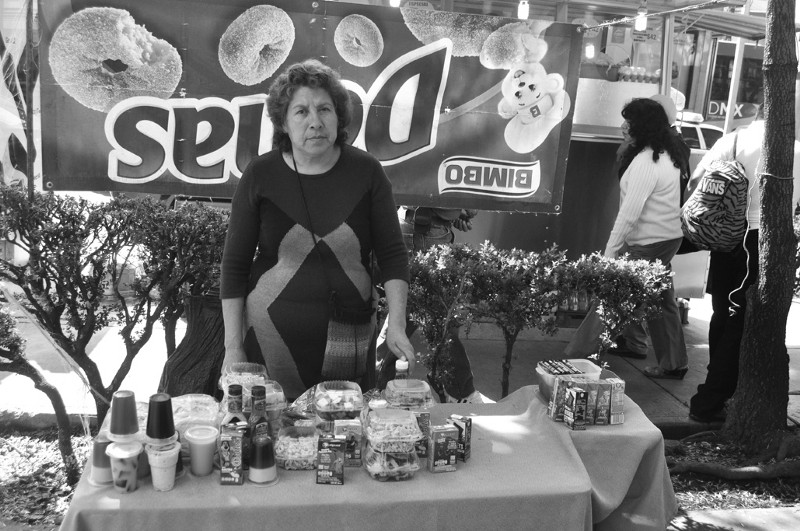
It seems unrealistic to think that refugees can find work that pays a better wage when Mexicans struggle to do so. “People can live on such low wages,” says Ramón Verdugo, a shelter director in Tapachula, “but will live like many Mexicans: in a culture of poverty.” One glimmer of hope is Arcoiris, in Tapachula, which offers job-training for asylum-seekers, granting certification in, among other things, refrigeration, baking and making clothes. Each class has around 50 students.
The US is recognizing — belatedly — the growing humanitarian crisis in Mexico. In 2016, Congress allocated $750 million in assistance to seven Central American countries, “primarily focused on improving the economic, social, governance and security conditions in those countries.” This is something that’s desperately needed in that region but it does little to help people fleeing now. On July 26th, 2016, the Obama administration announced new programs to aid asylum-seekers. The US, partnering with the UNHCR, will establish an in-country referral program aimed at identifying people who have a “credible refugee claim.” It further announced that Costa Rica, also working with the UNHCR, will begin a Protection Transfer Arrangement (PTA), temporarily accepting asylum applicants but only those pre-screened in their home countries. A State Department spokesperson said the screenings will take place “within the coming months.” No one knows how long they’ll take.
These programs sound positive but there are several concerns. The new programs require people to be interviewed “in country” and it’s difficult to imagine someone being threatened by Mara Salvatrucha waiting around to see if they qualify for asylum in another country. Costa Rica, through the PTA, has pledged to “host 200 individuals at a time for a period of six months” which is a paltry number. Finally, only those people pre-screened in their home countries are eligible. If they don’t enter Costa Rica through the PTA, they won’t be given temporary asylum.
José Luís Loera, the director of Casa Refugiados in Mexico City, has a long history of working with migrants and refugees, starting in 1983 when he worked in refugee camps along the Mexico/Guatemala border, which housed Guatemalans fleeing the civil war. He said there’s of Central American refugees being repatriated and that resettlement in other countries is increasingly remote. “There only remains integration,” he says. “And I will tell you in general, I am very pessimistic about integration in Mexico. Everything points that the situation will worsen…with lots of violence, economic violence…This combination of violence, impunity and corruption, there could be more and more attacks or more hostile atmosphere toward refugees. It will require economic and political changes in Mexico, and there is not the political will to implement changes.” He pulled out a map to show me the Mexican camps set up to house Guatemalan refugees. “Back in the 80s, we had hope that there would eventually be a peace agreement, that there would be reconciliation. I must tell you that, now, I have no hope.”
Joseph Sorrentino is a freelance photojournalist. He can be contacted at joso1444@usa.net.
View more of Joseph’s work at http://www.sorrentinophotography.com

